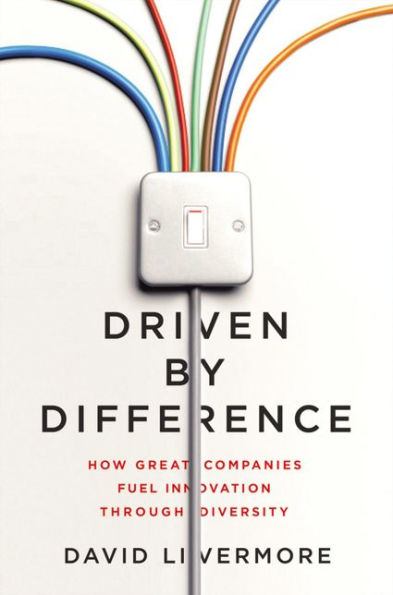
Driven by Difference: How Great Companies Fuel Innovation Through Diversity
240
Driven by Difference: How Great Companies Fuel Innovation Through Diversity
240Hardcover
-
SHIP THIS ITEMTemporarily Out of Stock Online
-
PICK UP IN STORECheck Availability at Nearby Stores
Available within 2 business hours
Related collections and offers
Overview

Product Details
| ISBN-13: | 9780814436530 |
|---|---|
| Publisher: | AMACOM |
| Publication date: | 02/17/2016 |
| Pages: | 240 |
| Product dimensions: | 6.10(w) x 9.10(h) x 1.20(d) |
| Age Range: | 18 Years |
About the Author
Read an Excerpt
INTRODUCTION
“Diversity leads to innovation!” That’s the mantra repeated by many diversity proponents. I just heard it again a couple of weeks ago from a diversity guru who spoke before me at an international leadership conference in New York. It makes sense.
Looking at a problem from a diversity of perspectives is likely to yield better solutions than viewing it solely from one myopic view.
But this rose-colored view of diversity doesn’t jive with reality. Just as two newlyweds quickly discover that vastly different perspectives on how to set up house don’t necessarily lead to better results a the same is true for multicultural teams that are coalescing on a project. a recently talked with a senior vice president from one of the largest global banks who told me his bank cut its diversity and inclusion budget by 90 percent because its leaders couldn’t see any return on investment from their diversity efforts. A couple of months ago, a group of South African executives told me, “We’re two decades post-apartheid and we’ve made very little progress in seeing better results from our incredibly diverse workforce.”
And many universities and governments around the world have abandoned affirmative action–type programs, suggesting it’s time to move on.
Meanwhile, there’s very limited diversity in many of the Silicon
Valley companies lauded as examples of innovation. Jeffrey Son-nefeld of Yale University believes tech firms place a premium on young white males. He says, “It’s sort of a throwback to an era we should be long past, which is the macho world of the giggling boys a with the hackers’ sensibility that somehow we are living in a pure meritocratic world.” Google executive Nancy Lee agrees, at least in part. She admits that Google’s workforce is predominantly white a and 83 percent of its tech workers are male. Along with other
Google executives, she is on a crusade to change that.
Should tech firms, banks, and universities recruit a more diverse workforce simply because of pressure from stakeholders that it’s the right thing to do? Or can a more compelling case be made for how a diverse workforce leads to greater innovation and success?
Are there economic advantages to having a more diverse team, or is it simply a straw man argument?
There’s no question that cultural diversity provides one of the greatest opportunities for global innovation. The potential is enormous. But it’s a correlation, not causation. An organization that learns how to utilize the diverse perspectives from multicultural teams has a tremendous opportunity to come up with better solutions. In fact, when used strategically, diversity is one of the greatest resources for coming up with innovative solutions, which in turn leads to economic benefits. Learning the managerial steps for translating diversity into innovation is the primary objective of this book.
How can you utilize diverse perspectives to come up with better solutions? And what part of the innovation process needs to be adjusted to leverage diversity for better innovation?
Those are the two primary questions this book will address.
Diversity by itself does not ensure innovation. Diversity combined with high cultural intelligence (CQ) does. Cultural intelligence is the capability to function effectively in culturally diverse situations. It’s rooted in rigorous academic research conducted by scholars around the world. I’ve written much about the four capabilities required to work and lead with cultural intelligence.
But this book reflects the next stage in our research on cultural intelligence: implementing a culturally intelligent process to drive innovation. Getting diverse teams to function at the highest levels of productivity requires a leader and team members with high CQ
and a plan for culturally intelligent innovation.
Table of Contents
CONTENTS
Introduction
1. Diversity is.
PART I: THE CLIMATE FOR CULTURALLY INTELLIGENT INNOVATION
2. The Power of Attention
3. The Power of the Empty Chair | Perspective Taking
4. The Power of 90 Minutes | Focus
5. The Power of Trees | Space
6. The Power of Trust
PART II: THE 5D PROCESS FOR CULTURALLY INTELLIGENT INNOVATION
7. Define: Align Diverse Expectations and Goals
8. Dream: Generate Diverse Ideas
9. Decide: Select and Sell Your Idea
10. Design: Create and Test for Diverse Users
11. Deliver: Implement Global Solutions
Epilogue
Acknowledgments
Appendix A: Cultural Intelligence—What’s Your CQ?
Appendix B: Glossary of Cultural Value Dimensions
Notes
Index
